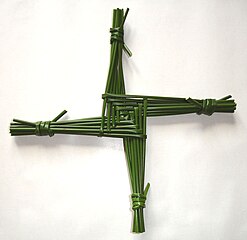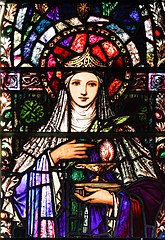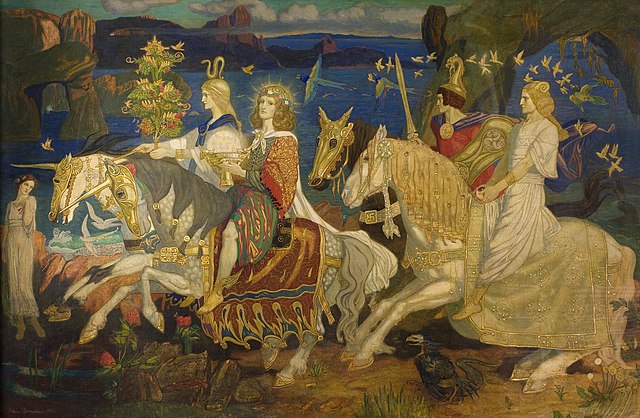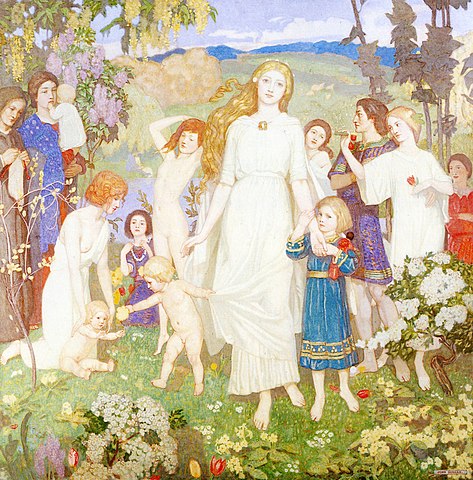Brigid: The Sacred Goddess of Irish Mythology
Goddess Brigid
Brigid is one of the most important and beloved goddesses in Irish mythology. Known as the goddess of poetry, healing, and craftsmanship, she held a special place in ancient Irish paganism. Brigid’s influence didn’t fade; when Ireland became Christian, many of her traits were carried over to Saint Brigid of Kildare, one of the country’s patron saints. This blending of pagan and Christian traditions shows Brigid is deeply involved in ancient and modern Irish culture.
In this article, we’ll explore Brigid’s mythology, the roles she played as a triple goddess, the symbols associated with her, and the lasting impact she has had on Irish folklore and culture. Brigid’s legacy continues to shine brightly, whether through the sacred flames of her shrines, the healing waters of her wells or the customs still celebrated today.
Table of Contents
Brigid’s Origins
Brigid is the daughter of the Dagda, one of the most powerful gods of the Tuatha Dé Danann, a group of supernatural beings in Irish mythology. The Dagda was known for his strength, wisdom, and magical powers; Brigid inherited many of these qualities. She became one of the most revered goddesses in ancient Ireland.
While Brigid’s father is well-known, the myths provide little information about her mother. Some stories mention her being connected to the Morrígan, but the traditional tales do not clearly confirm that. Instead, Brigid is mainly celebrated as a goddess of poetry, healing, and blacksmithing.
As a member of the Tuatha Dé Danann, Brigid played a crucial role in Irish mythology. She represented light, creativity, and life itself. Her importance as a goddess extended beyond her family ties, as she became a symbol of hope and inspiration for the people of Ireland.
The Triple Goddess
Brigid is often known as a triple goddess, meaning she embodies three important aspects: poetry, healing, and smithcraft. Each of these aspects represents a different part of life and the world around us.
- Poetry: Brigid is the goddess of inspiration and creativity. She is connected to the power of words, storytelling, and art, all bringing new ideas into the world. Poetry represents the spark of creation, making Brigid a symbol of birth and new beginnings.
- Healing: Brigid is also a goddess of healing and medicine. She is said to have the power to heal the sick, bless the land, and help crops grow. This aspect of Brigid represents life itself—she nurtures and protects, ensuring health and well-being.
- Smithcraft: As the goddess of Smithcraft, Brigid oversees metalwork and craftsmanship. Blacksmiths were highly respected in ancient Ireland, and Brigid’s connection to this craft shows her role in transformation. Just as metal is shaped and forged, Brigid’s influence reflects how things change over time. This aspect symbolises both life and death, as all things are shaped by time.
Together, these three aspects—poetry, healing, and smithcraft—represent the full cycle of life: birth, life, and death. Brigid’s power over creativity and productivity shows how deeply she is connected to the world’s natural cycles. She inspires, nurtures growth, and transforms what is old into something new.
The Festival of Imbolc

Imbolc is a crucial festival dedicated to Brigid, celebrated on February 1st, marking the beginning of spring. It was a time of hope and renewal as the days grew longer, and the light returned after the dark winter months. Imbolc was about celebrating fertility, new growth, and the promise of life returning to the land.
The Importance of Light and Renewal
Imbolc symbolised nature’s awakening, as seeds started to stir beneath the soil and the first signs of spring appeared. Brigid, a goddess of light, creativity, and fertility, was at the heart of this festival. Her connection to the sun and fire made her the perfect symbol of the returning light as people looked forward to warmer days and new beginnings.
Traditional Imbolc Rituals
Imbolc was also a time for rituals and blessings, many of which are still observed today. One of the most well-known customs is making Brigid’s small woven crosses made from rushes or straw. These crosses were hung over doorways or windows to protect homes from harm and bring good fortune in the coming year.
People would also invite Brigid’s spirit into their homes by preparing a bed for her, symbolising a welcome to the fertility goddess. Particular foods, like oatcakes or butter, were offered to honour her. Blessings of livestock, especially cows, were an essential part of the festival, as Brigid was closely connected to animals and the health of herds.
Overall, Imbolc was a time to honour Brigid’s healing powers, fertility, and protection and to look forward to the new life and opportunities that spring would bring. Brigid’s presence was felt through these traditions in every home, field, and community, keeping her influence alive through the changing seasons.
Symbols and Sacred Elements of Brigid
Brigid is associated with several powerful symbols and sacred elements that represent her influence over life, healing, and protection. Each element highlights her connection to nature, fire, water, and animals, all of which were vital to ancient Irish life.
Sacred Flame
The Irish goddess Brigid is deeply linked to fire, symbolising inspiration, healing, and transformation. As a triple goddess of poetry, healing, and smithcraft, each of her aspects is touched by fire—whether as the forge’s flame, the spark of creativity, or the inner warmth that restores life. In ancient Kildare, her priestesses tended a sacred, eternal flame in her honour, a tradition later carried on by Christian nuns devoted to Saint Brigid. Fire represents Brigid’s life-giving power, her protective nature, and her divine spark. It remains a powerful symbol of her enduring presence in both pagan and Christian traditions.
Healing Wells
Brigid is linked to fire and water, particularly sacred wells known for their healing powers. Throughout Ireland, there are holy wells dedicated to Brigid, where people would go to pray for healing and protection. Water was seen as a source of life and renewal, and Brigid’s wells were believed to have special powers to cure illness and bring blessings to those who visited them. These wells were often places of pilgrimage, and even today, many still visit Brigid’s wells to seek her healing touch.
Animals
Brigid has a special connection to livestock, especially cows, which were incredibly important in ancient Ireland. Cows provided milk, butter, and cheese—essential sources of food—and were often seen as a sign of wealth and prosperity. Brigid was called upon to protect animals and ensure they stayed healthy and fertile. Her influence over livestock shows her role as a nurturing and life-giving goddess, caring for both people and animals alike.
Each of these symbols—the flame, wells, animals, and the cross—reflects Brigid’s role as a goddess of life, healing, and creativity. They show how deeply connected she is to the natural world and the everyday lives of those who honoured her.
The Goddess Brigid and Saint Brigid

After the Christianisation of Ireland, the pagan attributes of the goddess Brigid were blended with the story of Saint Brigid of Kildare, creating a strong connection between the two figures. This process is known as syncretism, where the beliefs and traditions of one culture are merged with those of another. In this case, many of Brigid’s qualities as a goddess were carried over into the life of the Christian saint, making her a powerful figure in both the pagan and Christian traditions.
Shared Attributes
Like the goddess, Saint Brigid is associated with healing, fertility, and protection. She was known for her kindness, healing the sick, and caring for the poor. Saint Brigid also had a special connection to animals, particularly cows, which were essential to the Irish people for their milk and food. This mirrors the goddess Brigid’s role in protecting livestock and ensuring the fertility of the land.
The Fire and the Wells
Both Brigid the goddess and Saint Brigid are linked to fire and water. The eternal flame that burned in honour of the goddess Brigid at Kildare was kept alive by nuns in Saint Brigid’s Christian convent, showing the continuation of the fire as a symbol of light and inspiration. Similarly, many sacred wells dedicated to the goddess Brigid became associated with Saint Brigid, and people continued to visit these wells to seek healing and blessings.
Fertility and Protection
In both her forms—goddess and saint—Brigid was seen as a protector of women, children, and livestock. She was called upon to help with childbirth, ensure the health of babies, and bless the land so crops would grow. This overlap between the pagan goddess and the Christian saint helped the Irish people maintain a deep connection to their cultural roots, even as their religious beliefs evolved.
By blending the characteristics of the ancient goddess with the figure of Saint Brigid, the Irish could keep many of their old traditions alive while embracing Christianity. Today, both Brigid the goddess and Saint Brigid are celebrated for their roles as healers, protectors, and bringers of new life, making them two of the most influential figures in Irish culture.
Brigid’s Cross
One of Brigid’s most famous symbols is Saint Brigid’s Cross, a small cross made from rushes or straw, traditionally woven during the festival of Imbolc. These crosses were hung in homes and barns as a symbol of protection and good fortune. They were believed to keep harm away and bless the home for the coming year. The simple yet powerful design of Brigid’s Cross continues to symbolise her presence and protection, even today.
Brigid’s Role in Mythology

Brigid plays a significant role in Irish mythology, with stories that showcase her powers of creation, healing, and sorrow. One of the most well-known myths involving Brigid is the story of her son, Ruadán.
Ruadán’s Death and the Origin of Keening
In the Second Battle of Mag Tuired, a great conflict between the Tuatha Dé Danann and the Fomorians, Brigid’s son Ruadán was sent to kill the smith god Goibniu, who was creating weapons for the Tuatha Dé Danann. However, Ruadán was fatally wounded in the process and died in battle. When Brigid discovered the death of her son, she mourned him deeply, wailing in grief. Her sorrowful cries are said to have been the first keening, a traditional Irish lament for the dead. This myth highlights Brigid’s mother and healer’s role and deep connection to life and loss.
Brigid as a Smith
Brigid is also strongly connected to the craft of smithing, which involves working with metal and fire to create tools and weapons. Smithing was considered a sacred art in ancient Ireland, and Brigid, the goddess of smithcraft, held great power in this realm. She was believed to inspire blacksmiths with the creativity and skill to forge valuable and beautiful objects, symbolising her role as a creator. This association with fire and creation reflects her influence over transformation and growth.
Brigid’s Other Stories
Brigid’s healing skills are also well-known. She was called upon to heal the sick, bless the land, and protect animals, particularly cows, which were essential to the livelihood of the Irish people. In some stories, she is credited with creating the first whistle used by the Smiths to communicate with one another. At the same time, they worked, further connecting her to the power of invention and ingenuity.
Brigid’s role in mythology is vast, and her stories reflect her many gifts. Whether through her mourning, her healing touch, or her skill in crafting, Brigid stands as an influential figure who influences all aspects of life, from birth to death and everything in between.
Brigid’s Enduring Legacy
Brigid’s influence has endured through time, leaving a lasting mark on Irish culture and spirituality. Even after the arrival of Christianity, many of the traditions and stories surrounding Brigid continued to thrive. Her dual identity as a pagan goddess and a Christian saint has helped her remain a beloved figure in Ireland and beyond.
Brigid in Neopagan Practices
Today, Brigid is a significant figure in modern neopagan practices, including Wicca and Druidry. Many neopagans honour her as a goddess of creativity, healing, and inspiration, celebrating her connections to nature and the changing seasons. Rituals and festivals dedicated to Brigid often focus on themes of renewal and fertility, especially around Imbolc, which marks the beginning of spring. People celebrate her by lighting candles, weaving crosses, and performing rituals to honour her power and presence in their lives.
Saint Brigid’s Day
Brigid’s legacy is especially evident during St. Brigid’s Day on February 1st. This day is celebrated not only as a feast day for the saint but also as a continuation of the ancient festival of Imbolc. In many Irish communities, people create Saint Brigid’s crosses, bless their homes, and engage in various customs that honour her. St. Brigid’s Day serves as a reminder of her enduring importance and the deep connection between the goddess and the saint.
Cultural Symbol
Brigid, the goddess or saint, has become a cultural symbol of Irish identity and resilience. Her image and stories are woven into various aspects of Irish art, literature, and music. Whether through poetry, folklore, or contemporary practices, Brigid continues to inspire people by representing the strength of women, the power of creativity, and the nurturing aspects of nature.
Brigid’s legacy is a beautiful tapestry of ancient beliefs and modern practices. She remains a cherished figure who embodies the spirit of Ireland, reminding us of the importance of creativity, healing, and connection to the earth. As long as her stories are told and her traditions are practised, Brigid will continue to shine brightly in the hearts of those who honour her.

